Time-Dependent Damage Estimation of a High-Rise Steel Building Equipped with Buckling-Restrained Brace under a Series of Earthquakes and Winds
Abstract
1. Introduction
2. Target Steel Building with BRB Devices
2.1. Building Description
2.2. Numerical Model of the Target Building
2.3. Performance Evaluation of Target Building
2.3.1. Pushover Analysis
2.3.2. Natural Period and Mode Shape
2.3.3. Time History Analysis under Design Earthquakes
3. Procedure to Generate Probable Multi-Hazard Scenarios in Building Lifetime
4. Multi-Hazard Events
4.1. Earthquake Loads
4.2. Long-Duration Wind Loads
4.3. Multi-Hazard Timeline for the Target Building
5. Cumulative Damage Model
5.1. Fatigue Evaluation of BRBs Device
5.2. Variable-Load Cycle Counting
5.3. Strain–Cycle Relationship of BRBs
5.4. Miner’s Damage Rule
5.5. Plastic Strain Energy (PSE)
5.6. Cumulative Ductility Factor (CDF)
6. Result and Discussion
6.1. Outline of Analysis and Results
6.2. Story Drift Ratio of the Target Building
6.3. Cumulative Damage Index (CDI)
6.4. Plastic Strain Energy (PSE)
6.5. Cumulative Ductility Factor (CDF)
6.6. Maximum Ductility Factor of BRBs
7. Conclusions
- Although for the design earthquake and wind loads, as recommend by AIJ (2019), the target building satisfies the 1% story drift ratio, but the building performance under multi-hazard scenarios is about 2.0–5.0 times larger. It is because, first, the estimated intensities of multi-hazard events from the proposed procedure are slightly larger in comparison to the design earthquake; second, the contribution of multi-hazard scenarios to the progressive damage of BRBs amplifies the overall building’s performance.
- Under the multi-hazard scenarios, the progressive damage of BRBs that are in upper stories is considerably smaller than that of the BRBs located in lower stories. This is indicating that the BRBs in lower stories are severely prone to low-cycle fatigue damage in the building service period.
- The progressive damage of BRBs under multi-hazard scenarios, which is studied in terms of cumulative damage index (CDI), cumulative ductility factor (CDF), plastic strain energy (PSE), and maximum ductility, reveal that the fatigue life of a BRB is a multi-criteria issue. It is found that although the BRBs can satisfy one or two of the thresholds, under the successive application of wind and earthquake excitation, the devices fail to endure all the aforementioned criteria. Corresponding to the designated criteria, the fatigue life is variable as well. Therefore, the current study recommends the multi-criteria be incorporated in the design phase of the high-rise building with BRBs.
- Considering the multi-criteria investigated in this study, this study observed that the effective service life of BRBs is much smaller than the design service life.
- Under the successive analysis of multi-hazard scenarios, the ductility demand of BRBs is three times larger than that during Level-2 earthquakes.
Author Contributions
Funding
Institutional Review Board Statement
Informed Consent Statement
Data Availability Statement
Conflicts of Interest
References
- Fujimoto, M.; Wada, A.; Saeki, E.; Watanabe, A.; Hitomi, Y. A study on the unbounded brace encased in buckling-restraining concrete and steel tube. J. Struct. Eng. 1988, 34, 249–258. (In Japanese) [Google Scholar]
- Takeuchi, T. Buckling-Restrained Brace: History, Design and Applications. Key Eng. Mater. 2018, 763, 50–60. [Google Scholar] [CrossRef]
- Black, C.J.; Makris, N.; Aiken, I.D. Component Testing, Seismic Evaluation and Characterization of Buckling-Restrained Braces. J. Struct. Eng. 2004, 130, 880–894. [Google Scholar] [CrossRef]
- Tremblay, R.; Bolduc, P.; Neville, R.; Devall, R. Seismic testing and performance of buckling-restrained bracing systems. Can. J. Civ. Eng. 2006, 33, 183–198. [Google Scholar] [CrossRef]
- Ju, Y.K.; Kim, M.-H.; Kim, J.; Kim, S.-D. Component tests of buckling-restrained braces with unconstrained length. Eng. Struct. 2009, 31, 507–516. [Google Scholar] [CrossRef]
- Fahnestock, L.A.; Ricles, J.M.; Sause, R. Experimental Evaluation of a Large-Scale Buckling-Restrained Braced Frame. J. Struct. Eng. 2007, 133, 1205–1214. [Google Scholar] [CrossRef]
- Tsai, C.S.; Chen, W.S.; Lin, Y.C.; Yang, C.T.; Tsou, C.P. Seismic Responses of a Full-Scale Steel Structure Using Multi-Curved Buckling Restrained Braces. In Proceedings of the ASME 2007 Pressure Vessels and Piping Conference. Volume 8: Seismic Engineering, San Antonio, TX, USA, 22–26 July 2007; pp. 55–61. [Google Scholar] [CrossRef]
- Kaneki, Y.; Hikone, S.; Yamashita, T.; Iwata, M. Seismic Strengthening by buckling restrained braces arranged diagonally. J. Struct. Constr. Eng. 2008, 73, 2215–2222. [Google Scholar] [CrossRef][Green Version]
- Shima, Y.; Ding, Y.; Zhao, J. Proposal for the structural design method of a sustainable building structure system. J. Struct. Constr. Eng. 2009, 74, 1179–1185. (In Japanese) [Google Scholar] [CrossRef][Green Version]
- Alemayehu, R.W.; Kim, Y.; Bae, J.; Ju, Y.K. Cyclic Load Test and Finite Element Analysis of NOVEL Buckling-Restrained Brace. Materials 2020, 13, 5103. [Google Scholar] [CrossRef] [PubMed]
- Guerrero, H.; Ji, T.; Teran-Gilmore, A.; Escobar, J.A. A method for preliminary seismic design and assessment of low-rise structures protected with buckling-restrained braces. Eng. Struct. 2016, 123, 141–154. [Google Scholar] [CrossRef]
- Watanabe, A. Design and application of buckling-restrained braces. Intern. J. High-Rise Build. 2018, 7, 215–221. [Google Scholar]
- Çelebi, M.; Kashima, T.; Ghahari, F.; Koyama, S.; Taciroğlu, E.; Okawa, I. Before and after retrofit behavior and performance of a 55-storey tall building inferred from distant earthquake and ambient vibration data. Earthq. Spectra. 2017, 34, 1599–1626. [Google Scholar] [CrossRef]
- Di Sarno, L.; Manfredi, G. Seismic retrofitting with buckling restrained braces: Application to an existing non-ductile RC framed building. Soil Dyn. Earthq. Eng. 2010, 30, 1279–1297. [Google Scholar] [CrossRef]
- Almeida, A.; Ferreira, R.; Proença, J.M.; Gago, A.S. Seismic retrofit of RC building structures with Buckling Restrained Braces. Eng. Struct. 2017, 130, 14–22. [Google Scholar] [CrossRef]
- Saingam, P.; Sutcu, F.; Terazawa, Y.; Fujishita, K.; Lin, P.; Celik, O.C.; Takeuchi, T. Composite behavior in RC buildings ret-rofitted using buckling-restrained braces with elastic steel frames. Eng. Struct. 2020, 219, 110896. [Google Scholar] [CrossRef]
- Castaldo, P.; Tubaldi, E.; Selvi, F.; Gioiella, L. Seismic performance of an existing RC structure retrofitted with buckling restrained braces. J. Build. Eng. 2021, 33, 101688. [Google Scholar] [CrossRef]
- Takeuchi, T.; Wada, A. Review of buckling-restrained brace design and application to tall buildings. Key Eng. Mater. 2018, 763, 50–56. [Google Scholar] [CrossRef]
- RSMC Tokyo-Typhoon Center: Best Track Data (1951–2020), Japan Meteorological Agency (JMA). Available online: https://www.jma.go.jp/jma/jma-eng/jma-center/rsmc-hp-pub-eg/besttrack.html (accessed on 3 February 2021).
- Duthinh, D.; Simiu, E. Safety of Structures in Strong Winds and Earthquakes: Multihazard Considerations. J. Struct. Eng. 2010, 136, 330–333. [Google Scholar] [CrossRef]
- Usami, T.; Wang, C.; Funayama, J. Low-Cycle Fatigue Tests of a Type of Buckling Restrained Braces. Procedia Eng. 2011, 14, 956–964. [Google Scholar] [CrossRef]
- Wang, C.-L.; Usami, T.; Funayama, J. Improving Low-Cycle Fatigue Performance of High-Performance Buckling-Restrained Braces by Toe-Finished Method. J. Earthq. Eng. 2012, 16, 1248–1268. [Google Scholar] [CrossRef]
- Liu, Y.S.; Chen, K.P.; Li, G.Q.; Sun, F.F. Low-Cycle Fatigue Performance of Buckling Restrained Braces and Assessment of Cumulative Damage under Severe Earthquakes. Key Eng. Mater. 2018, 763, 867–874. [Google Scholar] [CrossRef]
- Xu, Z.-D.; Dai, J.; Jiang, Q.-W. Study on fatigue life and mechanical properties of BRBs with viscoelastic filler. Steel Compos. Struct. 2018, 26, 139–150. [Google Scholar]
- Tong, C.; Wu, J.; Hua, K.; Xie, L. Low-Cycle Fatigue Life Estimation Curve for Buckling-Restrained Braces Based on Cumulative Plastic Deformation. J. Earthq. Eng. 2020, 1–29. [Google Scholar] [CrossRef]
- Repetto, M.P.; Solari, G. Wind-induced fatigue collapse of real slender structures. Eng. Struct. 2010, 32, 3888–3898. [Google Scholar] [CrossRef]
- Jia, J. Wind and structural modelling for an accurate fatigue life assessment of tubular structures. Eng. Struct. 2011, 33, 477–491. [Google Scholar] [CrossRef]
- Fang, Z.; Li, A.; Li, W.; Shen, S. Wind-Induced Fatigue Analysis of High-Rise Steel Structures Using Equivalent Structural Stress Method. Appl. Sci. 2017, 7, 71. [Google Scholar] [CrossRef]
- Hoveidae, N. Ultra-low cycle fatigue fracture life of a type of buckling restrained brace. J. Rehabil. Civ. Eng. 2018, 6, 29–42. [Google Scholar]
- AIJ. Recommendations for Loads on Buildings; Architectural Institute of Japan: Tokyo, Japan, 2019. [Google Scholar]
- BSL. The Building Standard Law of Japan; The Building Center of Japan: Tokyo, Japan, 2004. [Google Scholar]
- JSSI. Report of Investigation Committee on Response Control Buildings; The Japan Society of Seismic Isolation: Tokyo, Japan, 2012. [Google Scholar]
- Kasai, K.; Fu, Y.; Watanabe, A. Passive Control Systems for Seismic Damage Mitigation. J. Struct. Eng. 1998, 124, 501–512. [Google Scholar] [CrossRef]
- Saito, T. Structural Earthquake Response Analysis 3D, Version 10.5 (STERA_3D v10.5). 2020. Available online: http://www.rc.ace.tut.ac.jp/saito/software-e.html (accessed on 27 February 2021).
- Roy, T.; Saito, T.; Matsagar, V. Multihazard framework for investigating high-rise base-isolated buildings under earthquakes and long-duration winds. Earthq. Eng. Struct. Dyn. 2020, 50, 1334–1357. [Google Scholar] [CrossRef]
- Saito, T. Structural Earthquake Response Analysis WAVE Version 1.0 (STERA_WAVE v1.0). 2019. Available online: http://www.rc.ace.tut.ac.jp/saito/software-e.html. (accessed on 27 February 2021).
- Jennings, P.C.; Housner, G.W.; Tsai, N.C. Simulated earthquake motions for design purpose. In Proceedings of the 4th World Conference on Earthquake Engineering, Santiago, Chile, 13–18 January 1969; pp. 145–160. [Google Scholar]
- Wang, J.; Cheynet, E.; Snæbjörnsson, J.; Jakobsen, J.B. Coupled aerodynamic and hydrodynamic response of a long span bridge suspended from floating towers. J. Wind. Eng. Ind. Aerodyn. 2018, 177, 19–31. [Google Scholar] [CrossRef]
- Deodatis, G.; Shinozuka, M. Weighted Integral Method. II: Response Variability and Reliability. J. Eng. Mech. 1991, 117, 1865–1877. [Google Scholar] [CrossRef]
- Deodatis, G. Simulation of Ergodic Multivariate Stochastic Processes. J. Eng. Mech. 1996, 122, 778–787. [Google Scholar] [CrossRef]
- Marsh, G.; Wignall, C.; Thies, P.R.; Barltrop, N.; Incecik, A.; Venugopal, V.; Johanning, L. Review and application of Rain-flow residue processing techniques for accurate fatigue damage estimation. Int. J. Fatigue 2016, 82, 757–765. [Google Scholar] [CrossRef]
- Hasegawa, H.; Takeuchi, T.; Iwata, M.; Yamada, S.; Akiyama, H. Dynamic performances of unbonded braces. AIJ Tech. Rep. 1999, 9, 103–106. (In Japanese) [Google Scholar] [CrossRef]
- Nakamura, H.; Takeuchi, T.; Maeda, Y.; Nakata, Y.; Sasaki, T.; Iwata, M.; Wada, A. Fatigue properties of practical-scale unbonded braces. Nippon. Steel Tech. Rep. 2000, 82, 51–57. [Google Scholar]
- Yamaguchi, M.; Yamada, S.; Takeuchi, T.; Wada, A. Seismic performance of buckling resistant brace within a steel frame in the case of ultimate earthquake. J. Constr. Steel. 2004, 12, 207–210. (In Japanese) [Google Scholar]
- Takeuchi, T.; Uchiyama, T.; Suzuki, K.; Ookouchi, Y.; Ogawa, T.; Kato, S. Seismic retrofit of truss tower structures using buckling restrained braces. J. Struct. Constr. Eng. 2005, 589, 129–136. (In Japanese) [Google Scholar] [CrossRef][Green Version]
- Takeuchi, T.; Ida, M.; Yamada, S.; Suzuki, K. Estimation of Cumulative Deformation Capacity of Buckling Restrained Braces. J. Struct. Eng. 2008, 134, 822–831. [Google Scholar] [CrossRef]
- Chung, Y.W.; Lee, W.J. Cyclic plastic strain energy as a damage criterion and environmental effect in Nb-bearing high strength, low alloy steel. Mater. Sci. Eng. A 1994, 186, 121–128. [Google Scholar] [CrossRef]
- Iwata, M.; Murai, M. Buckling-restrained brace using steel mortar planks; performance evaluation as a hysteretic damper. Earthq. Eng. Struct. Dyn. 2006, 35, 1807–1826. [Google Scholar] [CrossRef]
- Takeuchi, T.; Ohyama, T.; Ishihara, T. Cumulative cyclic deformation capacity of high-strength steel frames with energy dis-sipation braces—Seismic performance of high-strength steel frames with energy braces part 1. J. Struct. Constr. Eng. 2010, 75, 1671–1679. [Google Scholar] [CrossRef][Green Version]
- Takeuchi, T.; Hajjar, J.F.; Matsui, R.; Nishimoto, K.; Aiken, I.D. Effect of local buckling core plate restraint in buckling restrained braces. Eng. Struct. 2012, 44, 304–311. [Google Scholar] [CrossRef]
- FEMA-450. NEHRP Recommended Provisions for Seismic Regulations for New Buildings and Other Structures; Federal Emergency Management Agency: Washington, DC, USA, 2003. [Google Scholar]
- Sabelli, R. Research on Improving the Design and Analysis of Earthquake-Resistant Steel Braced Frames; EERI: Oakland, CA, USA, 2001. [Google Scholar]
- Usami, T.; Kasai, A.; Kato, M. Behavior of buckling restrained brace members. In Proceedings of the 4th International Con-ference on STESSA 2003—Behavior of Steel Structures in Seismic Areas, Naples, Italy, 9–12 June 2003; pp. 211–216. [Google Scholar]
- ANSI/AISC 360-10. Seismic Provisions of Structural Steel Buildings; American Institute of Steel Construction: Chicago, IL, USA, 2010. [Google Scholar]
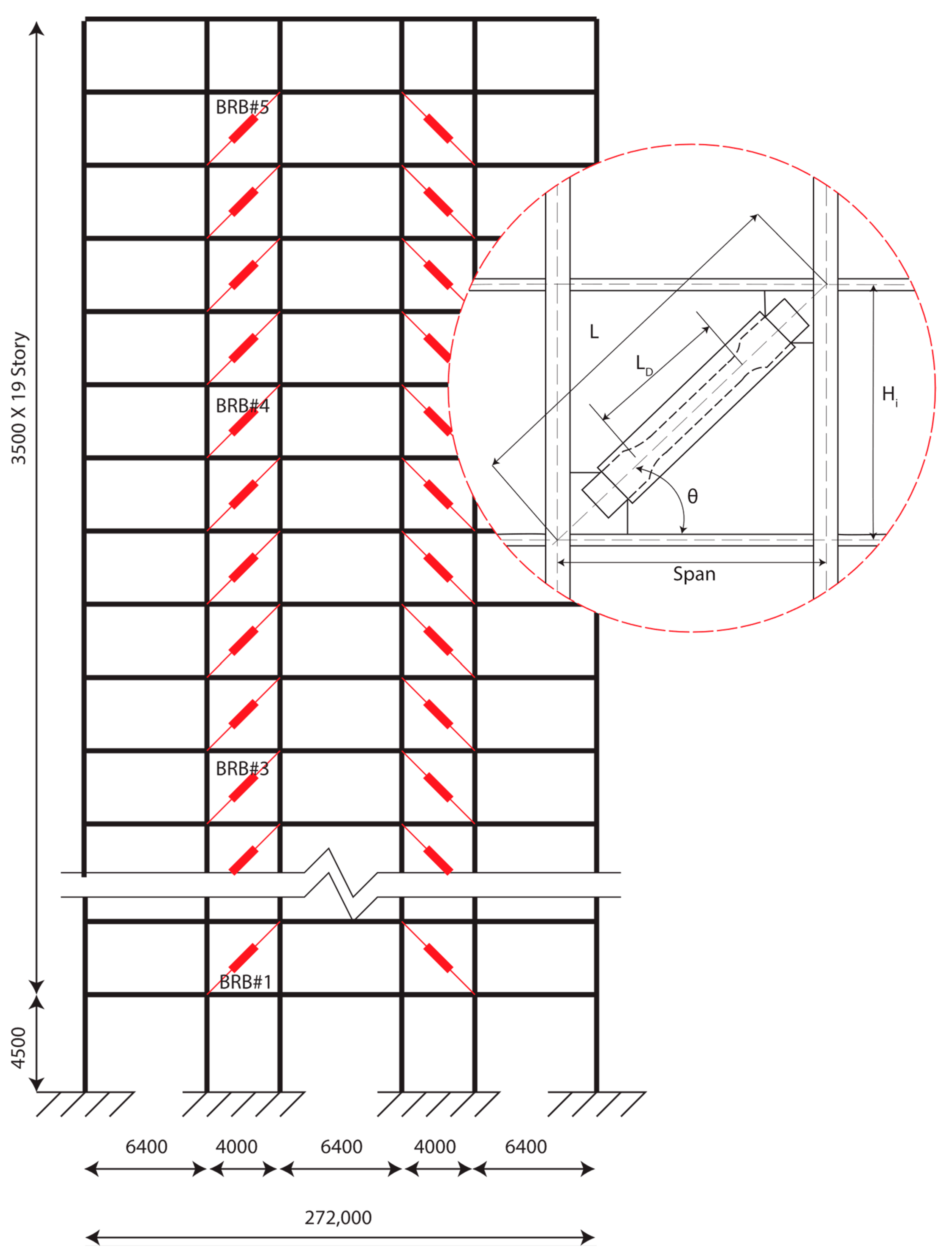
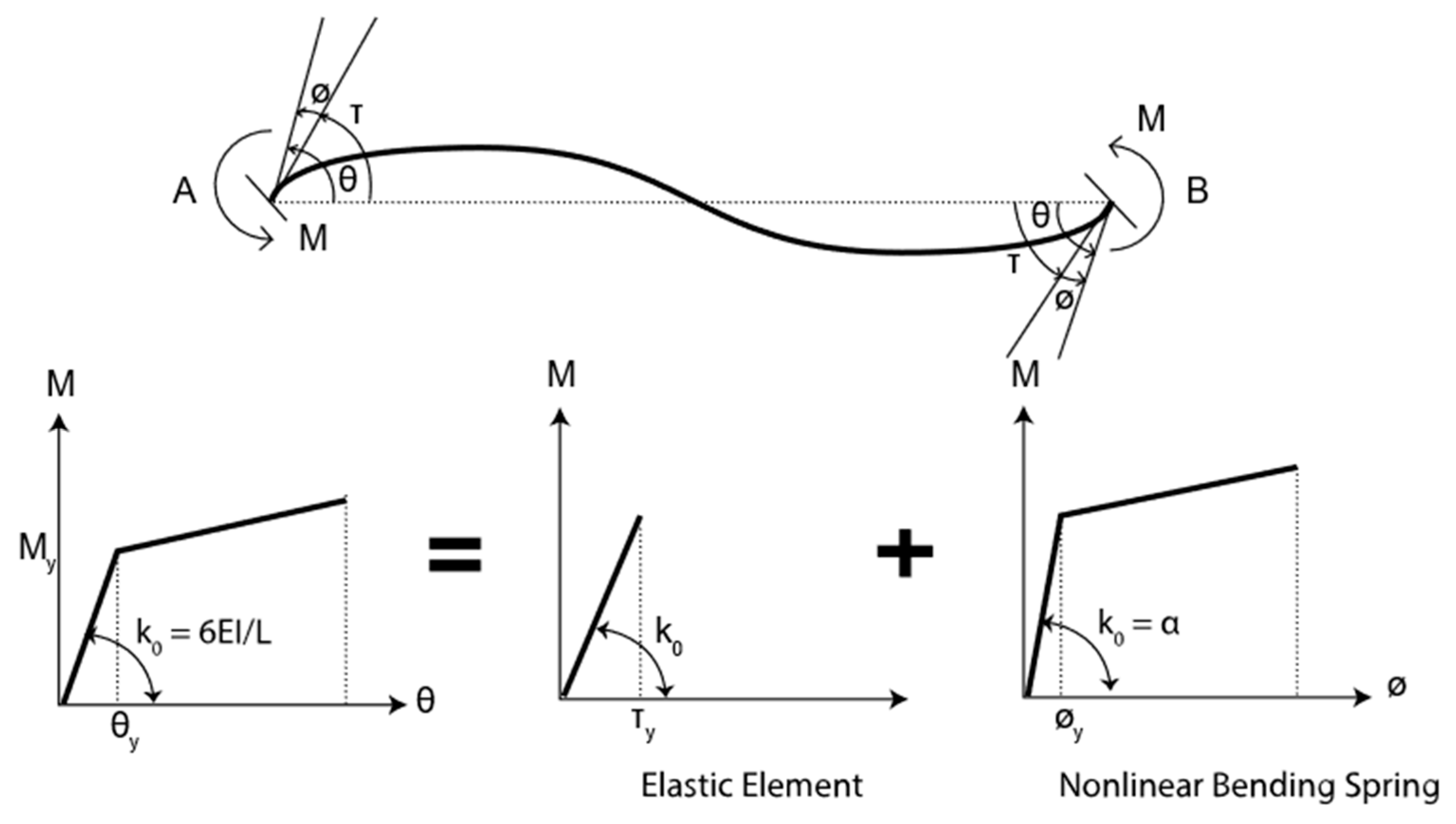
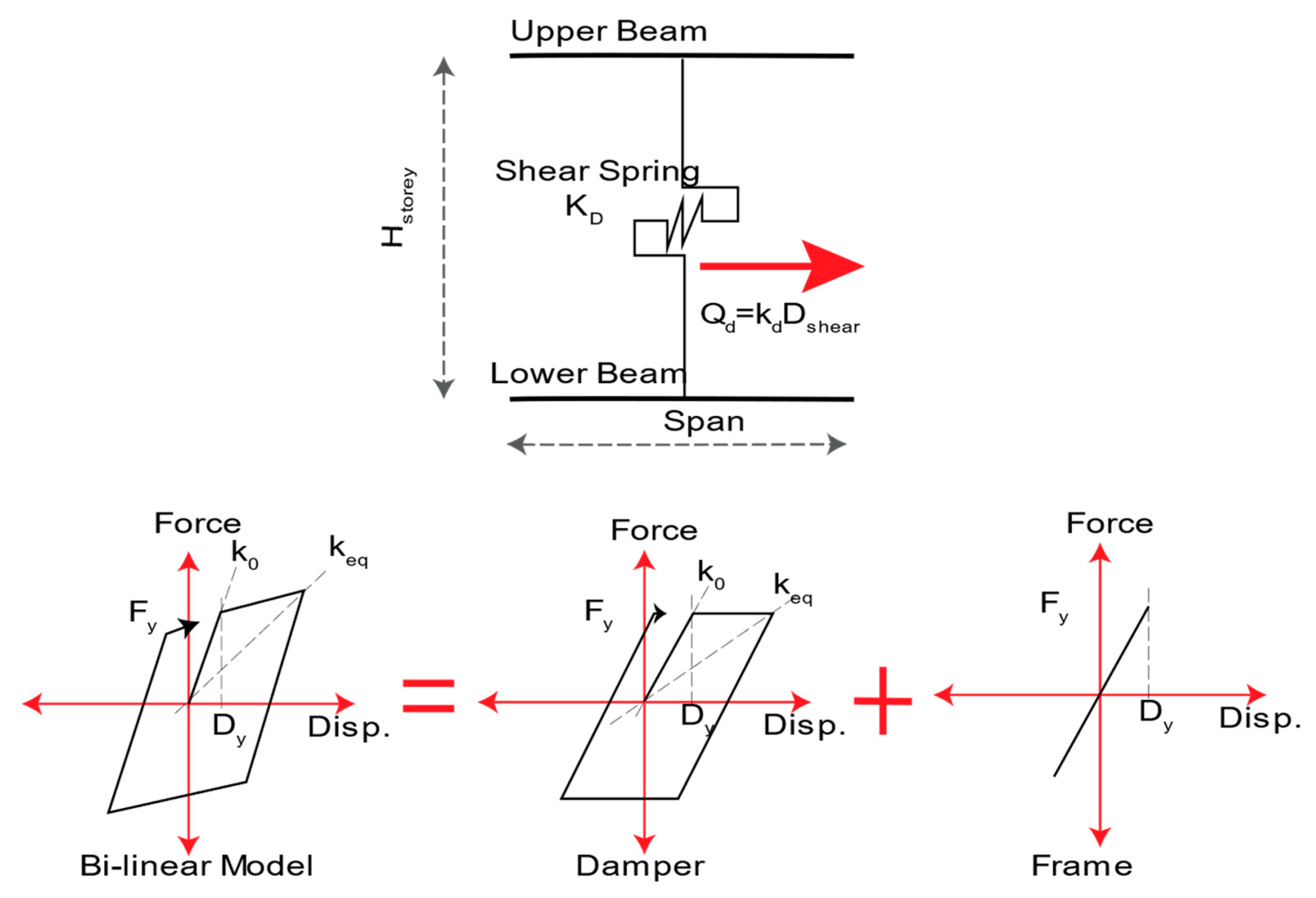
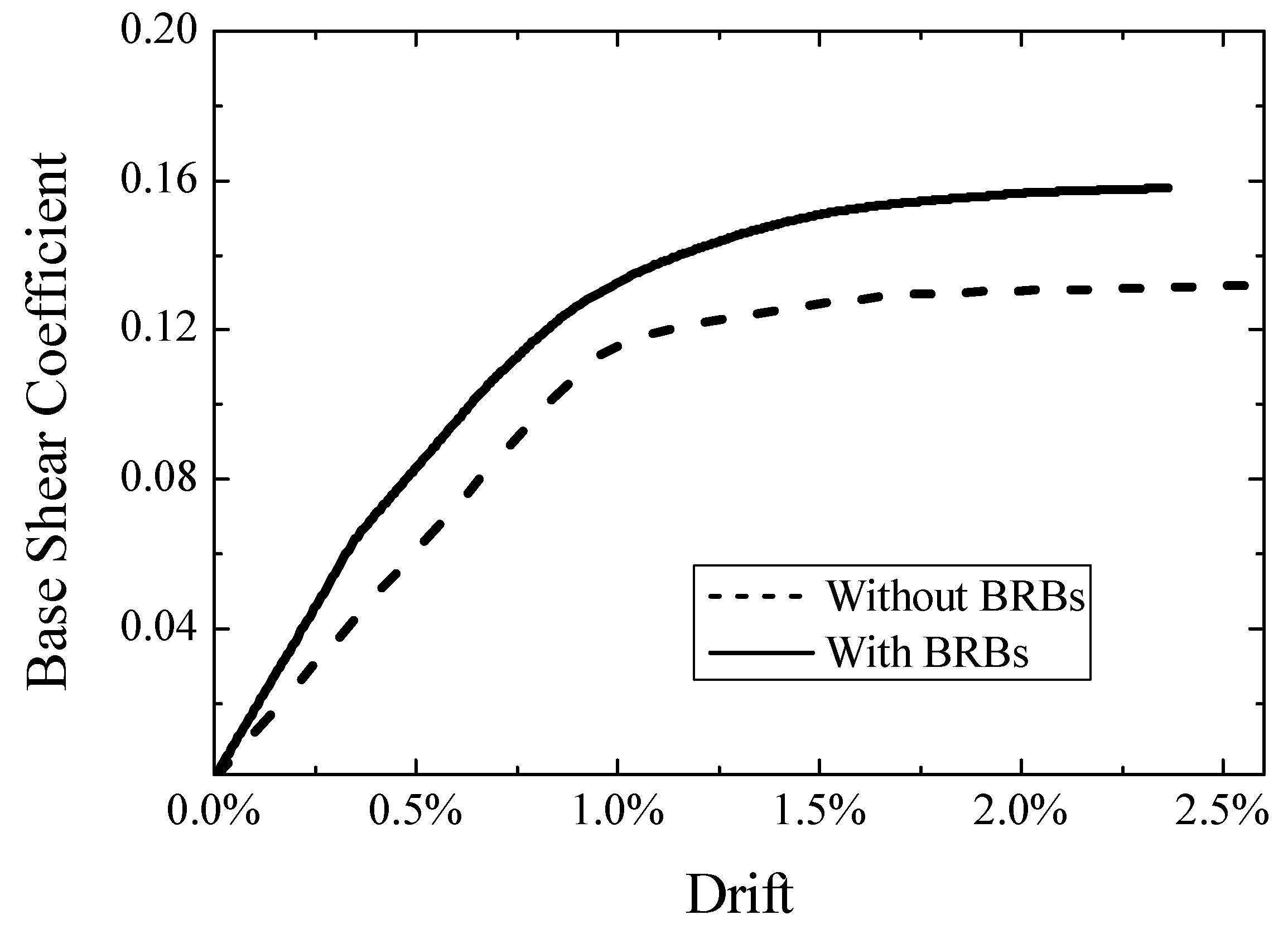
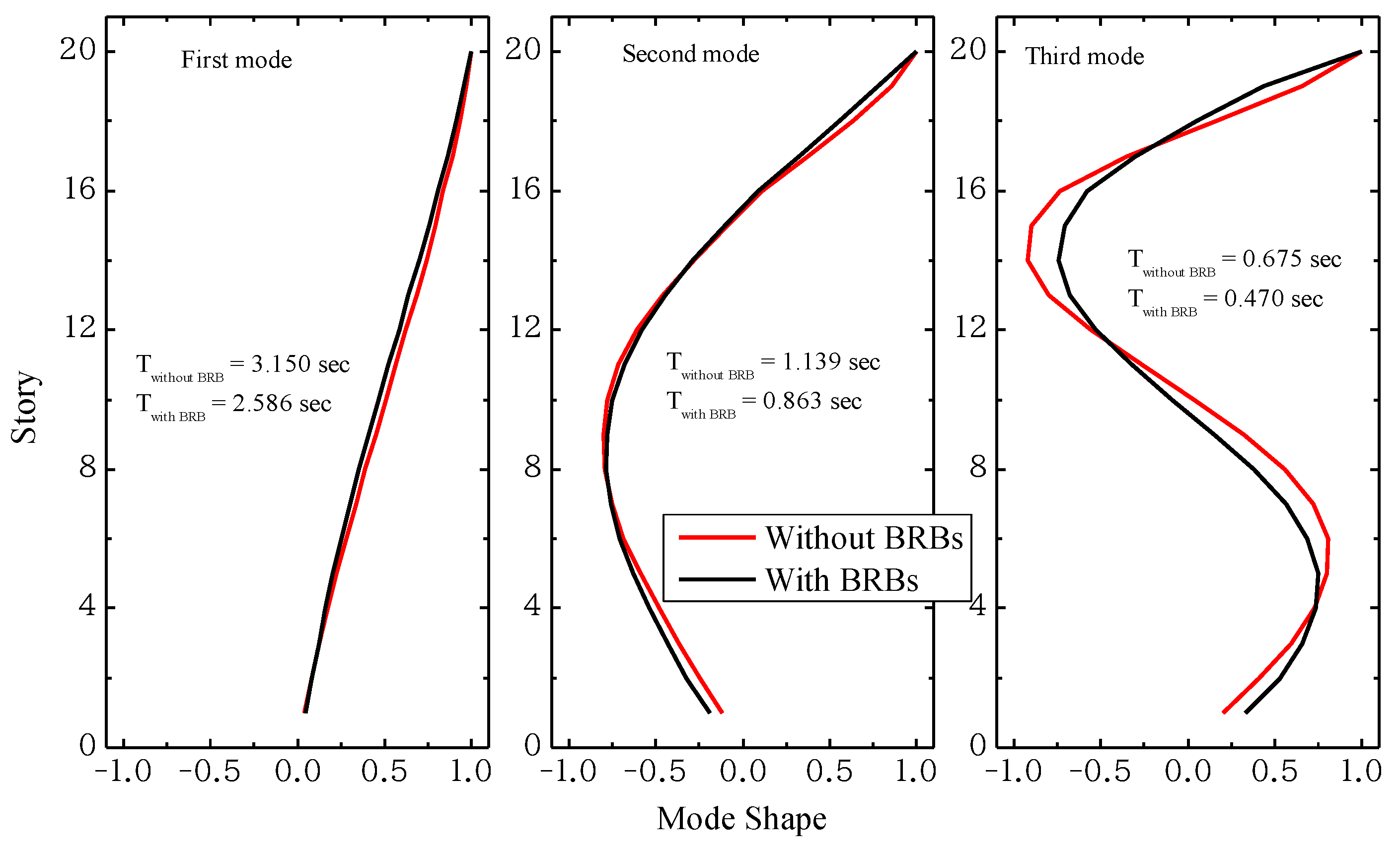
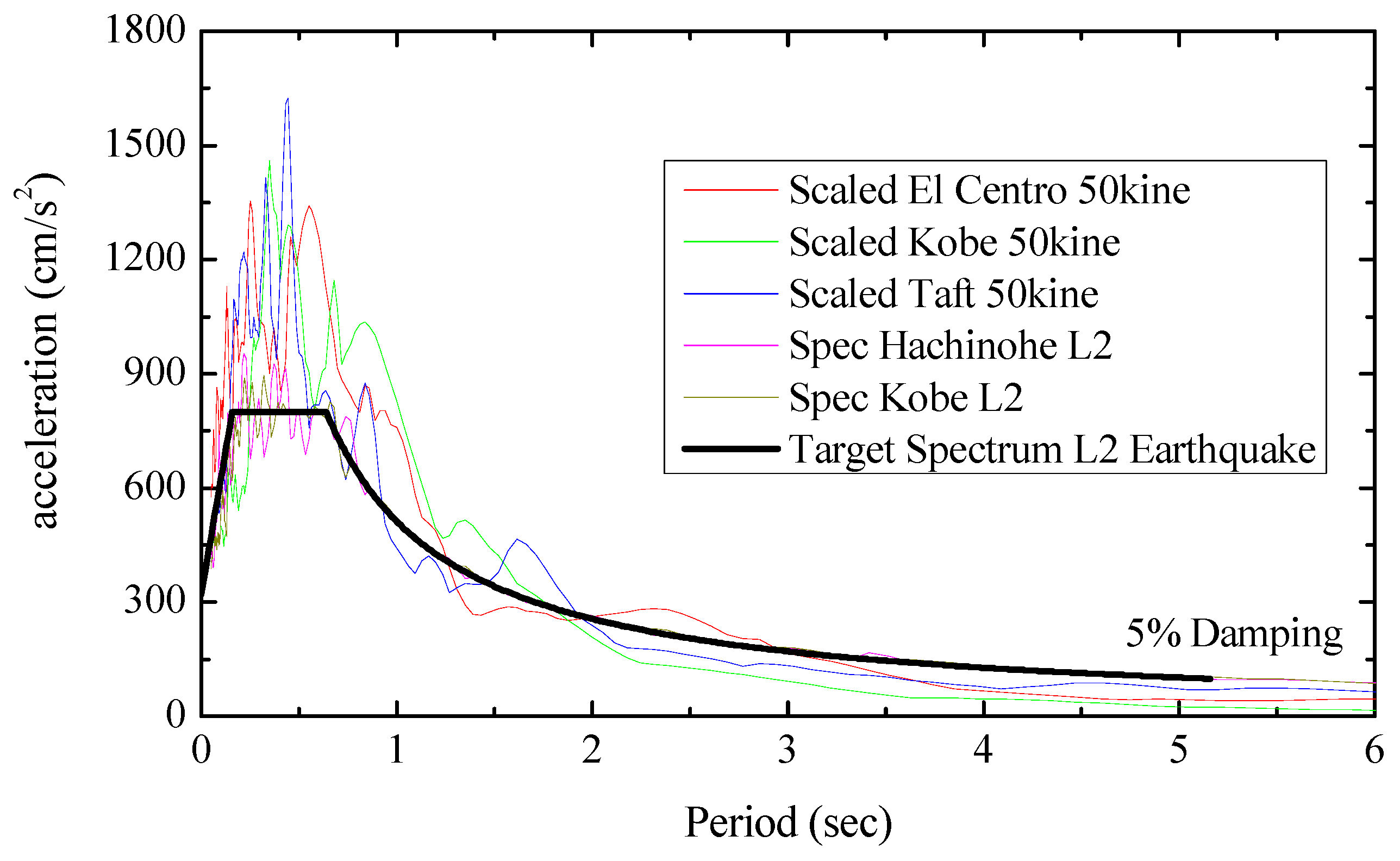
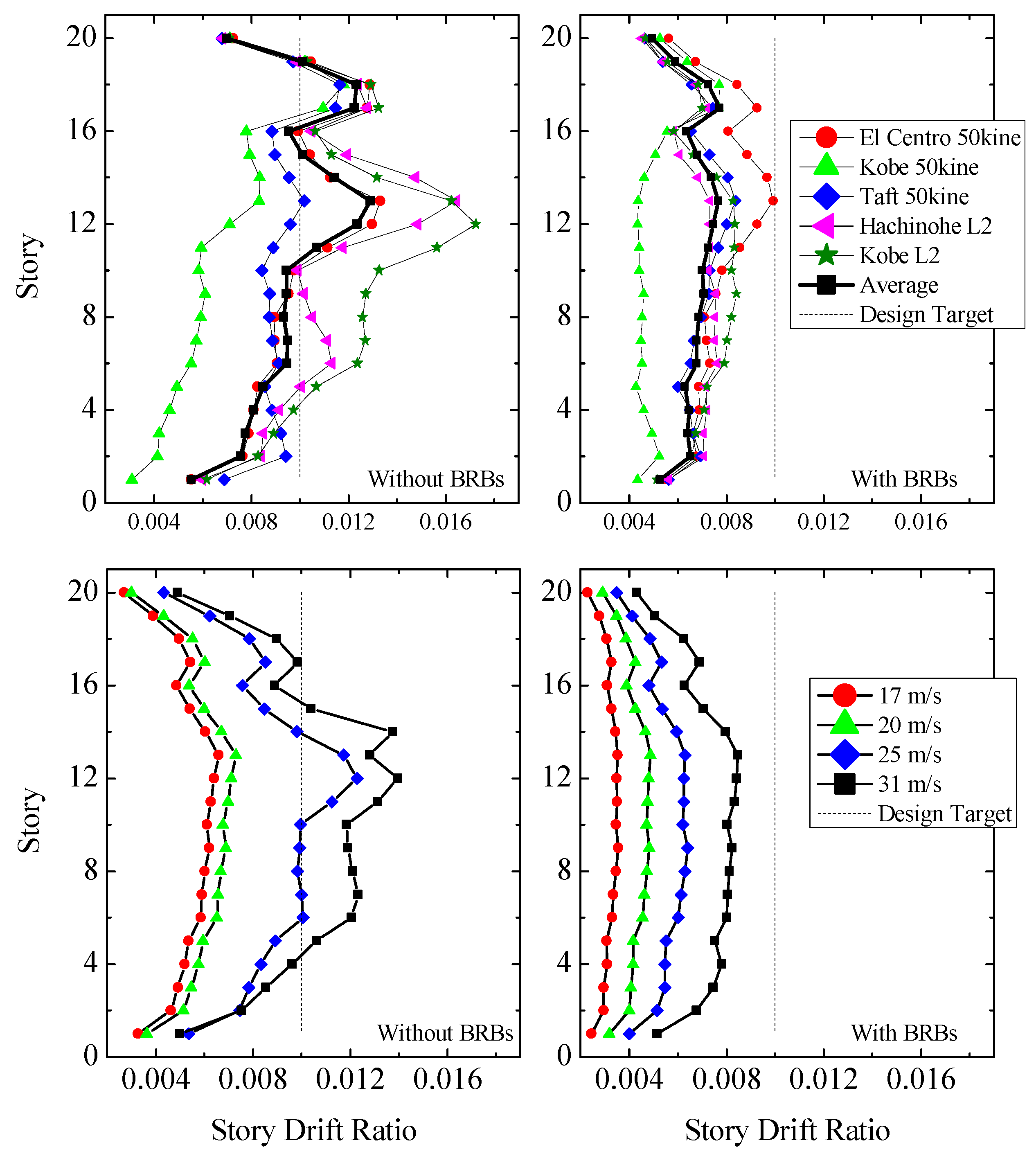
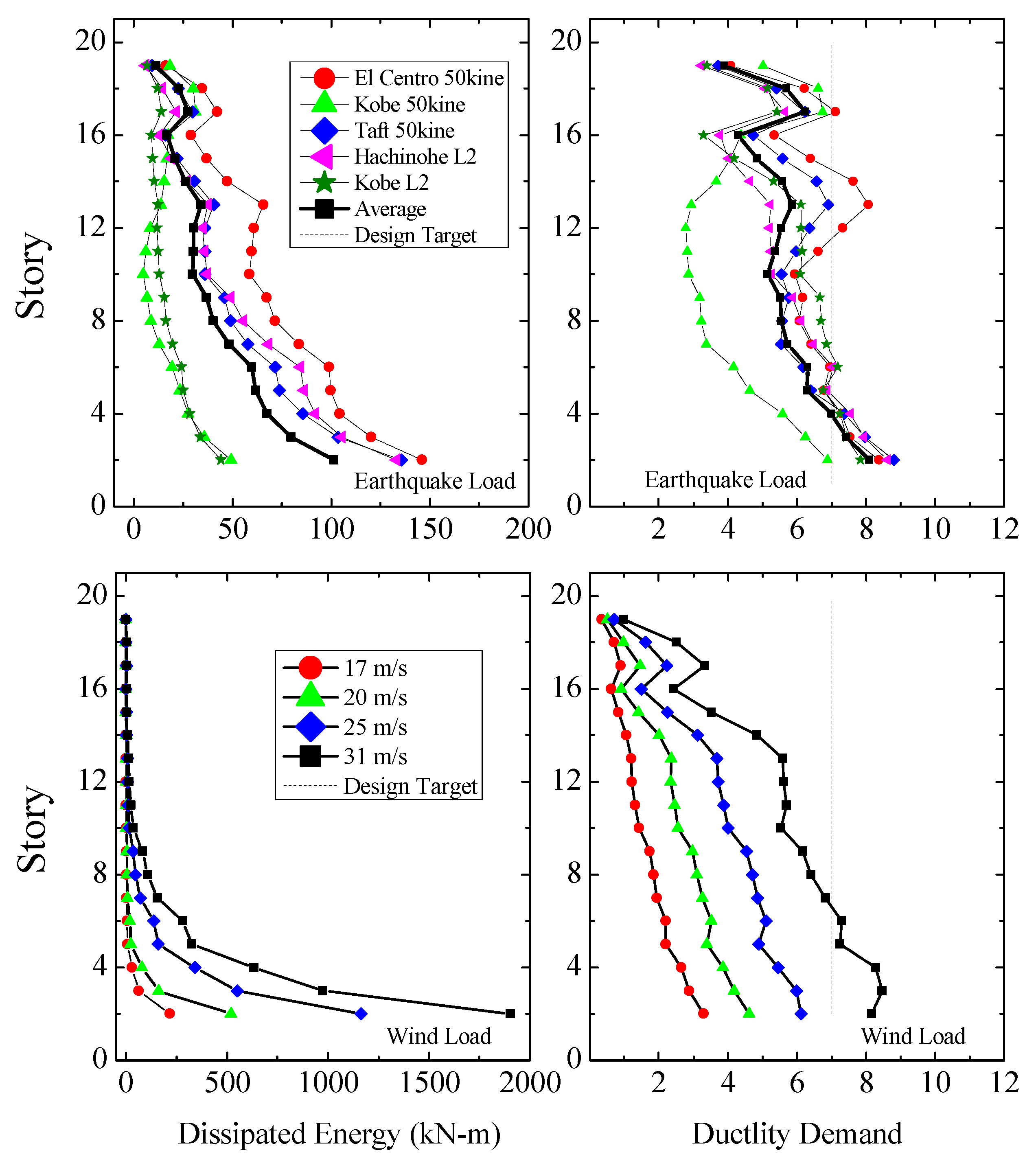
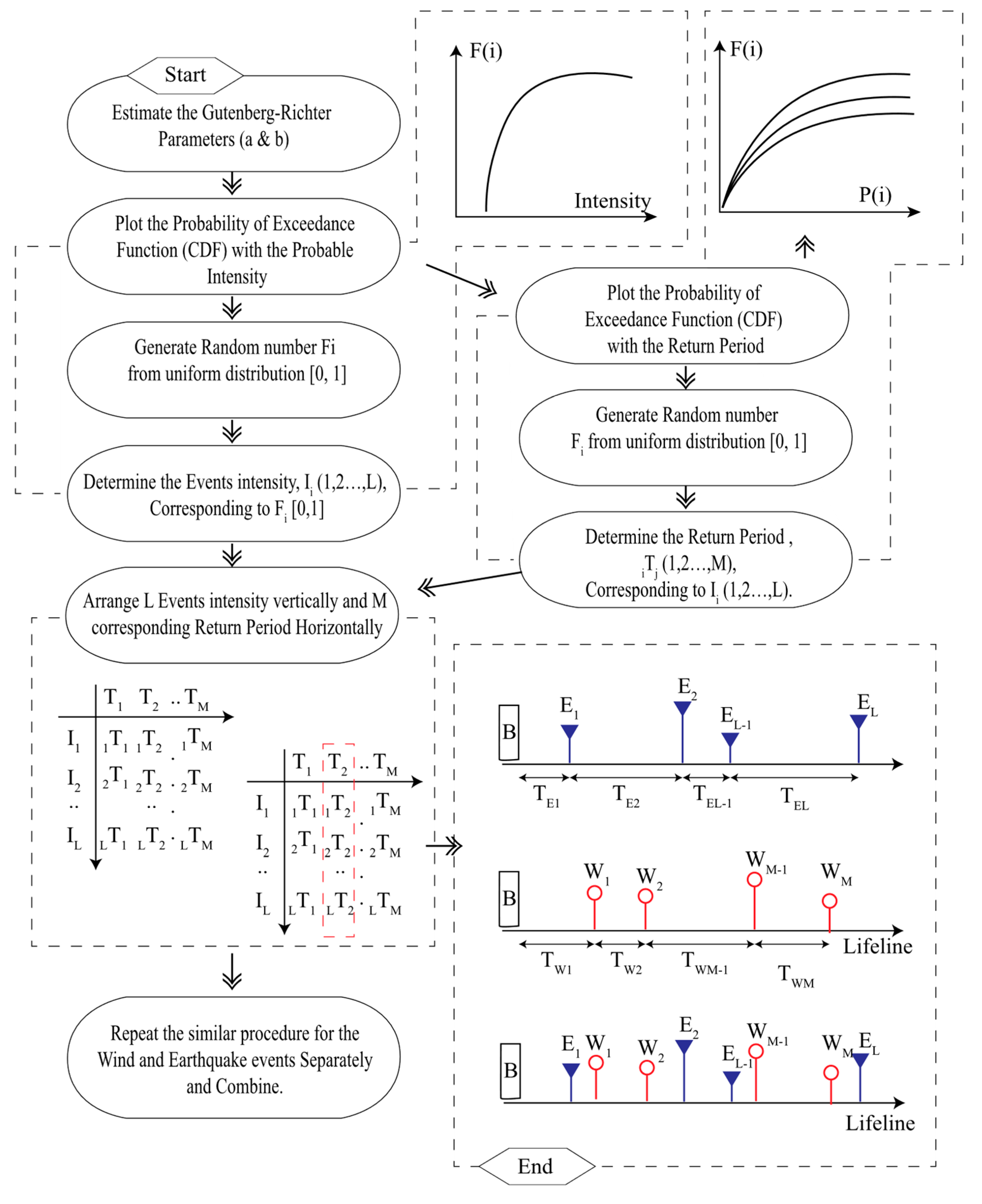
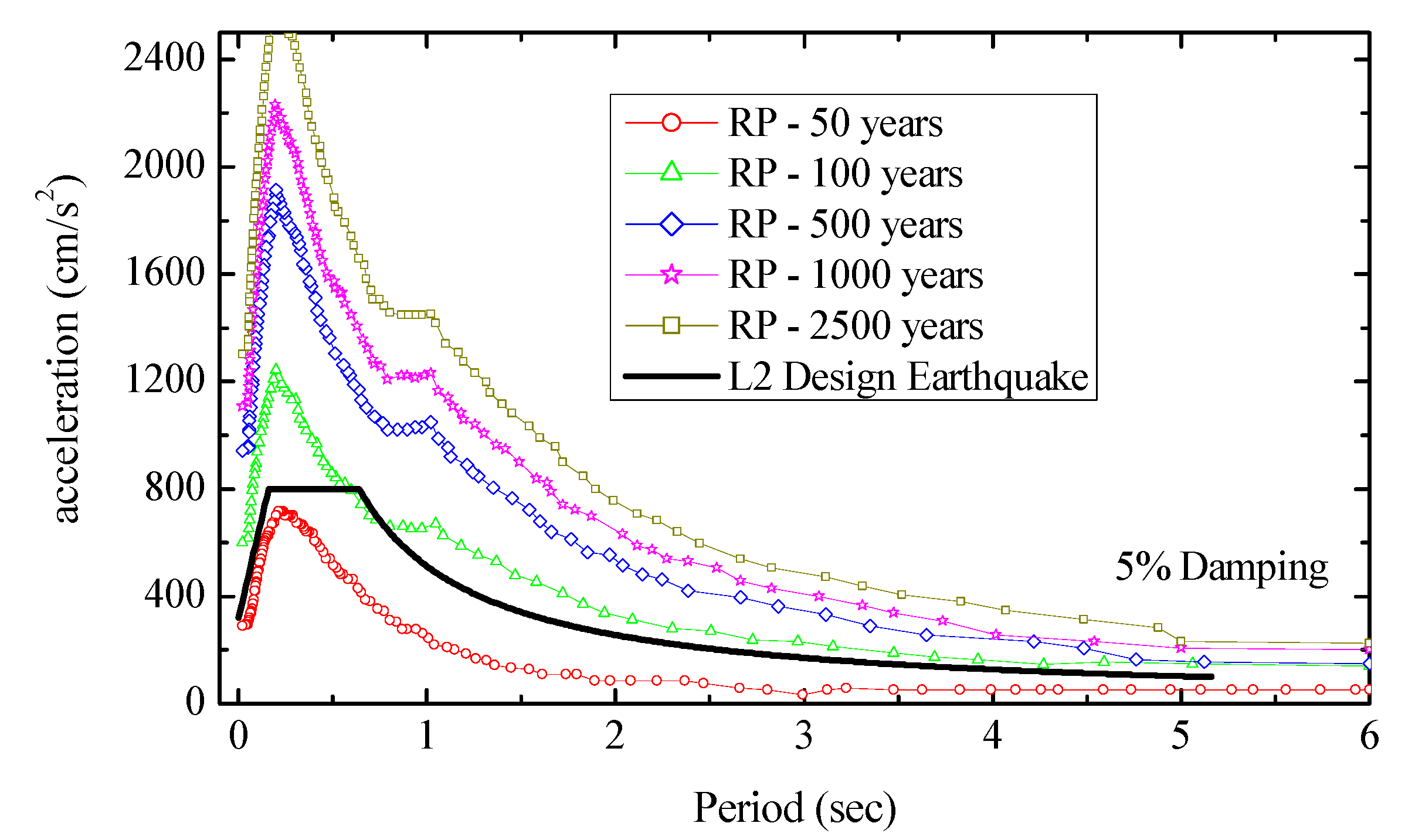
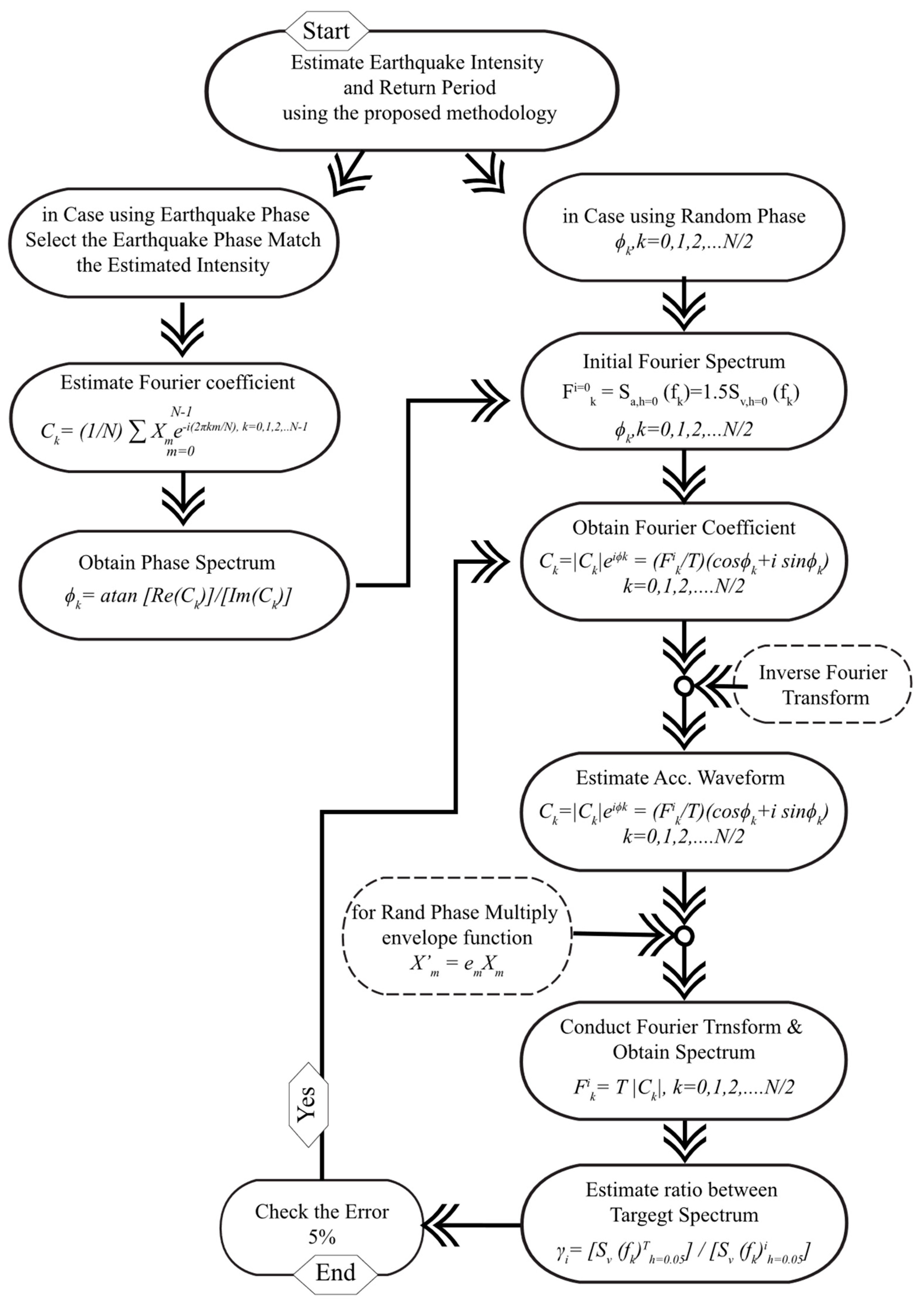
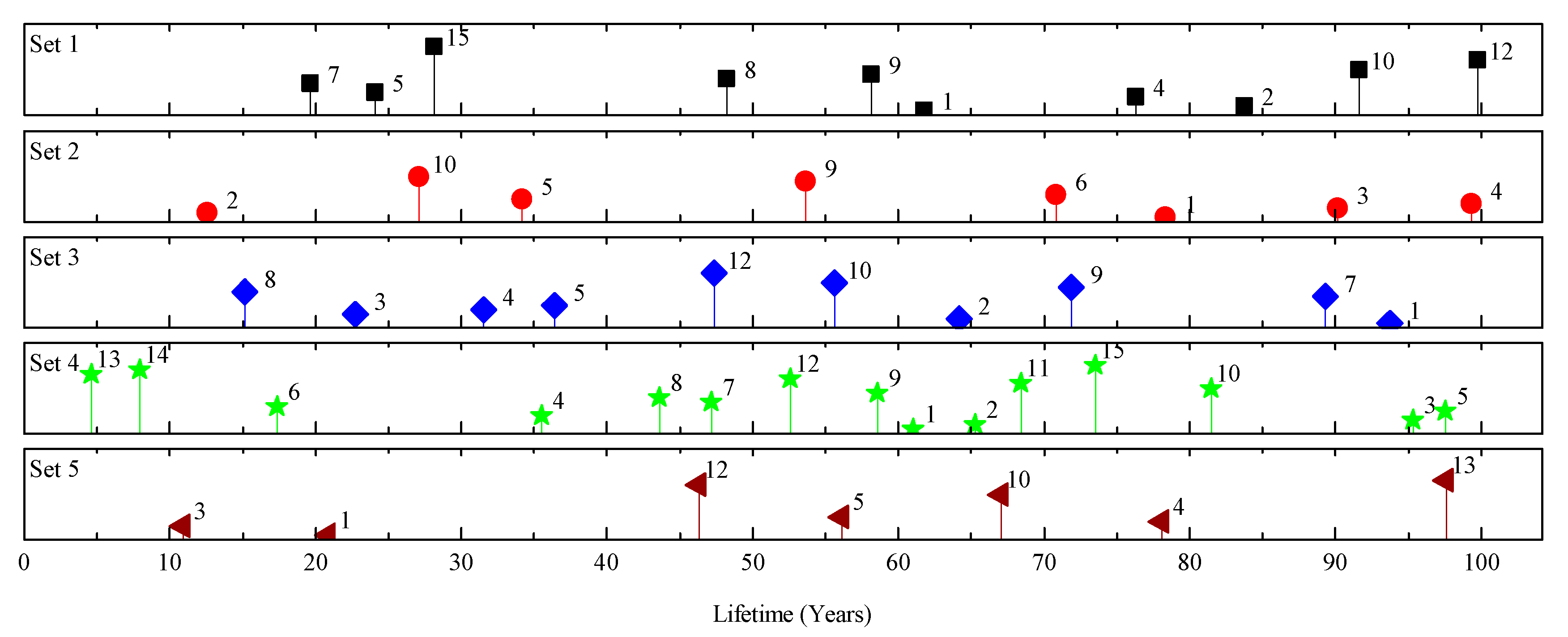
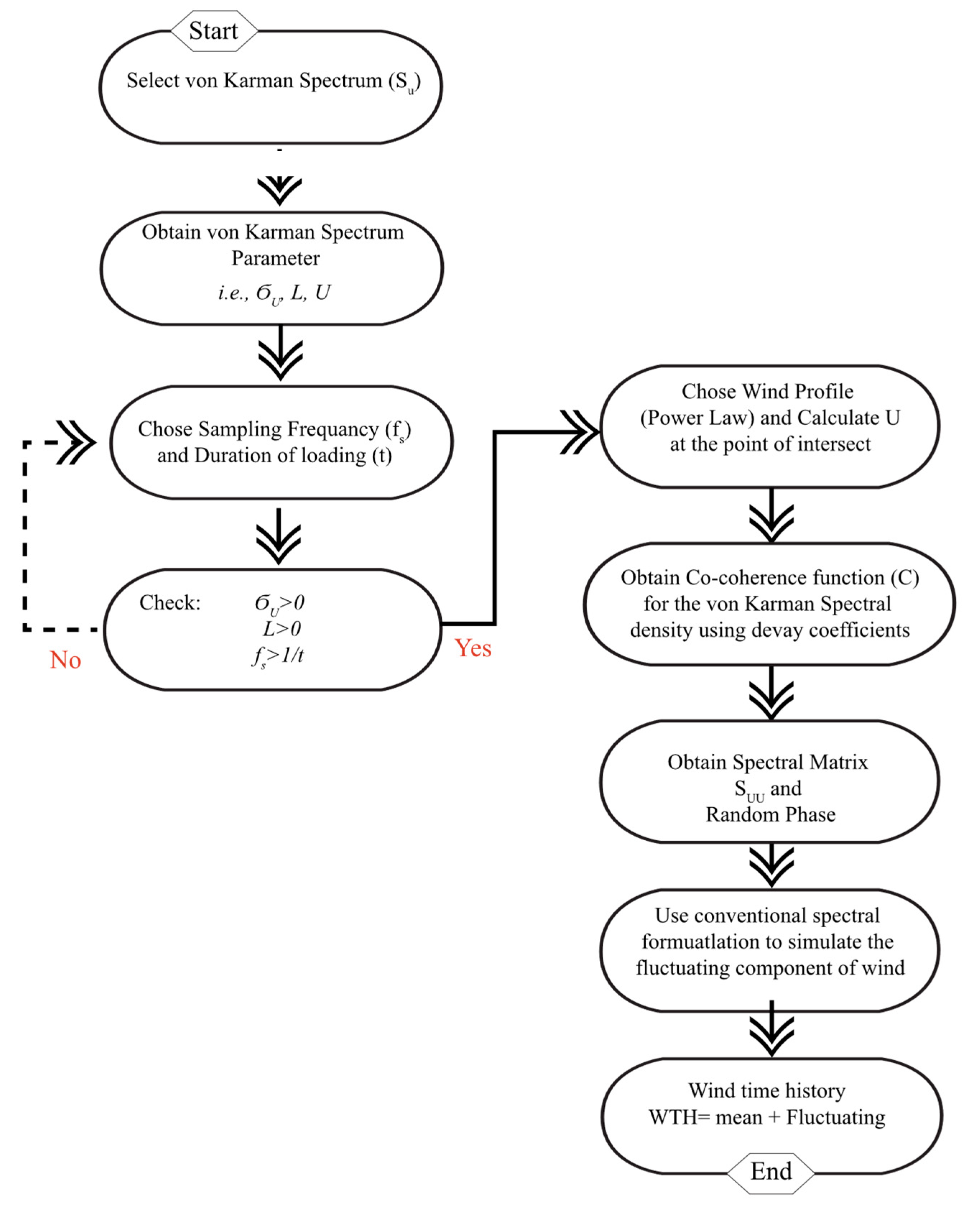
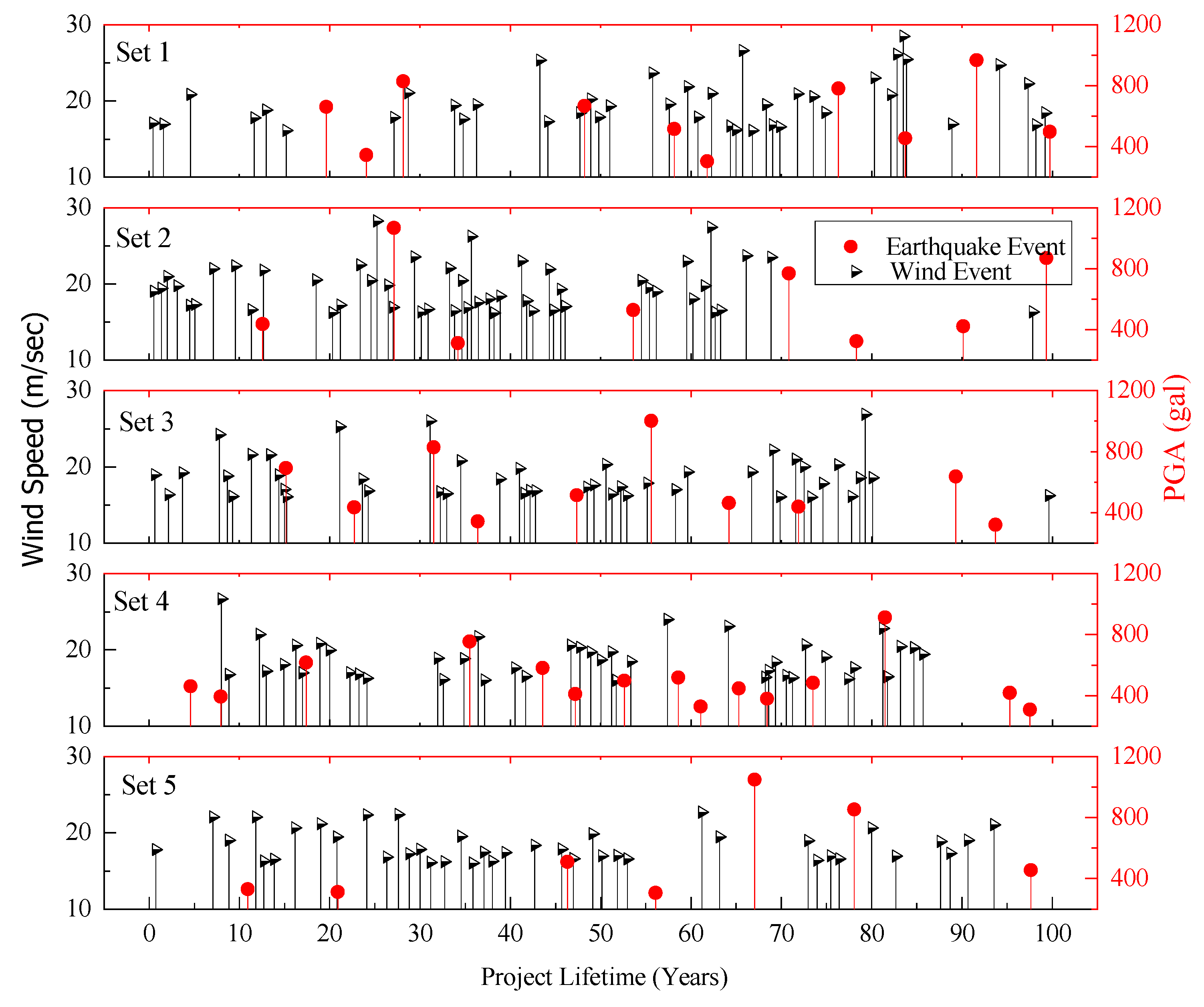
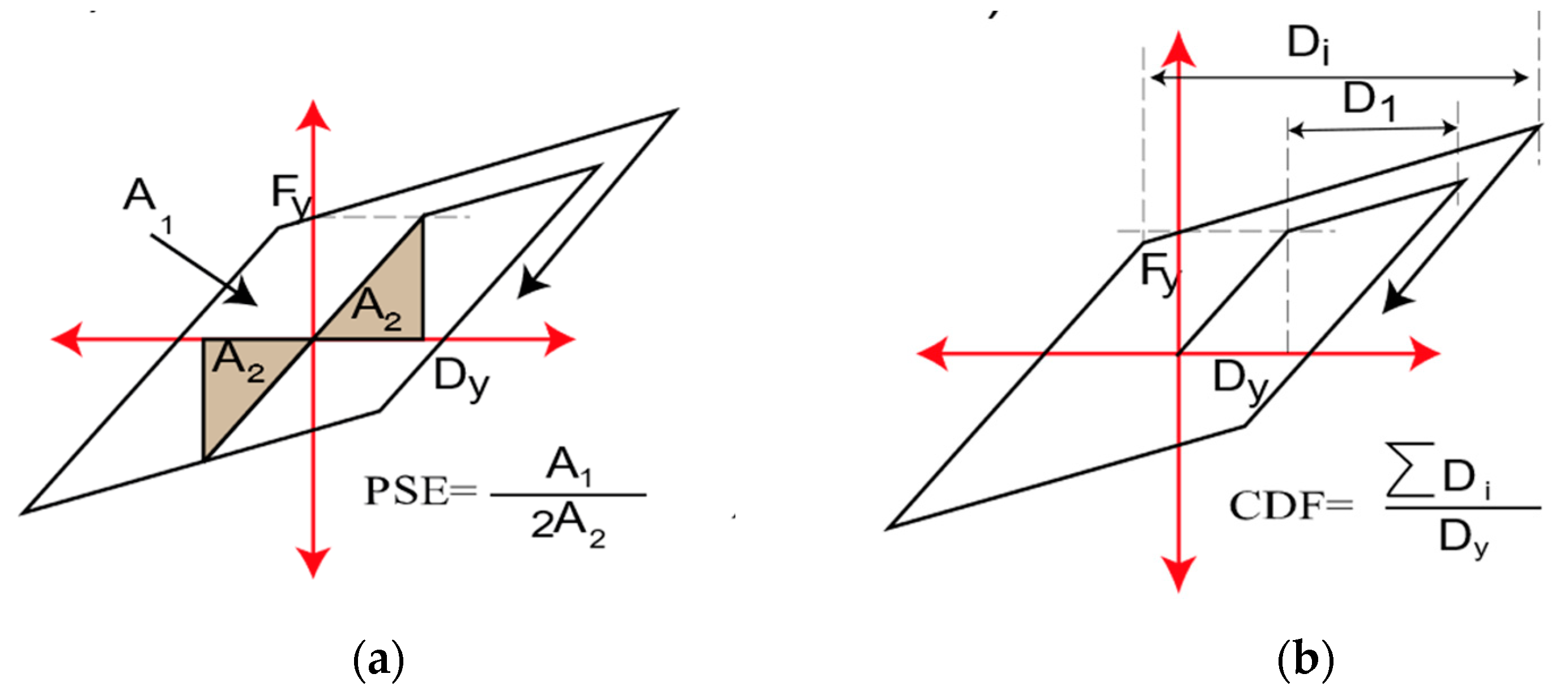

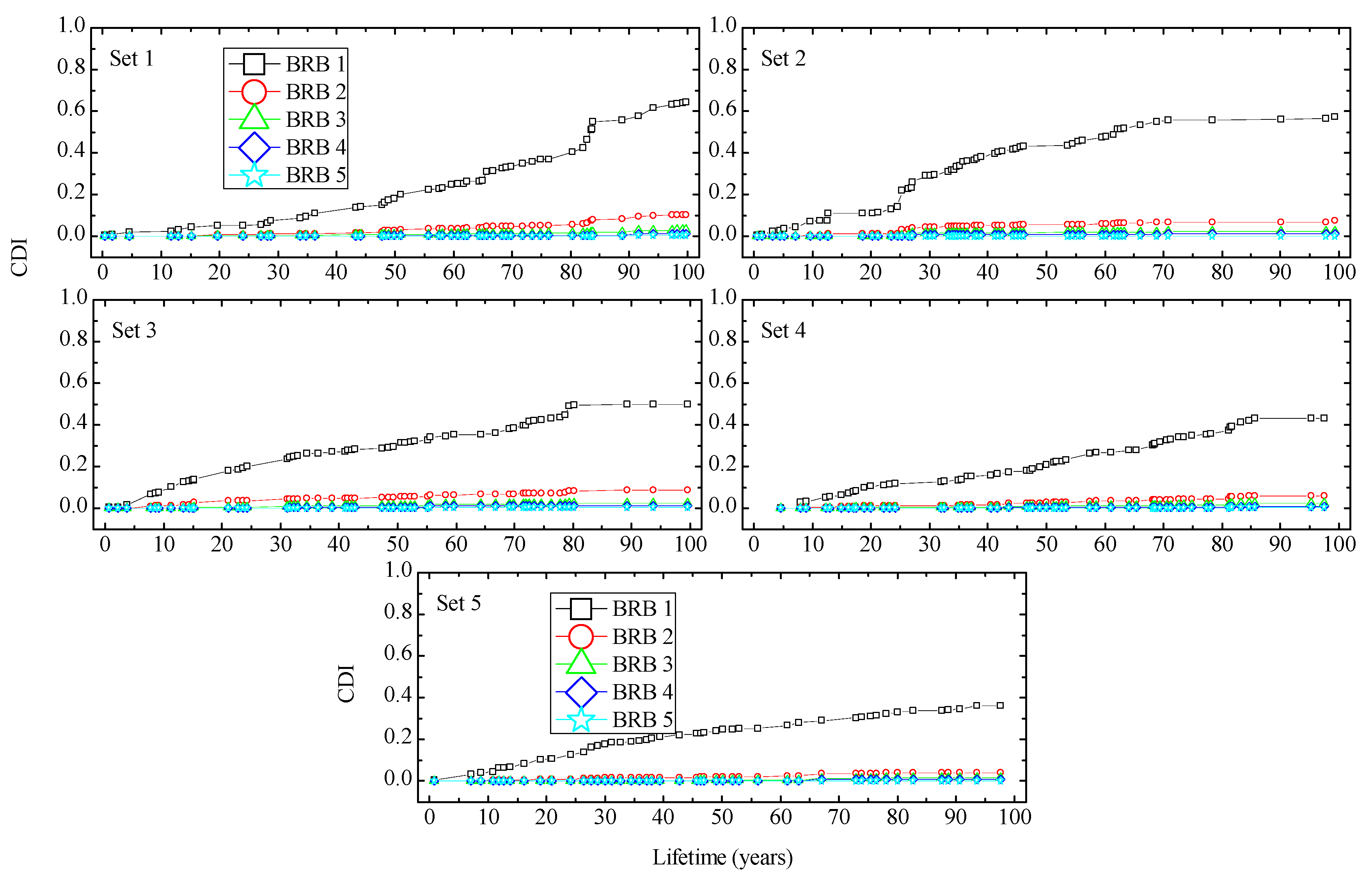
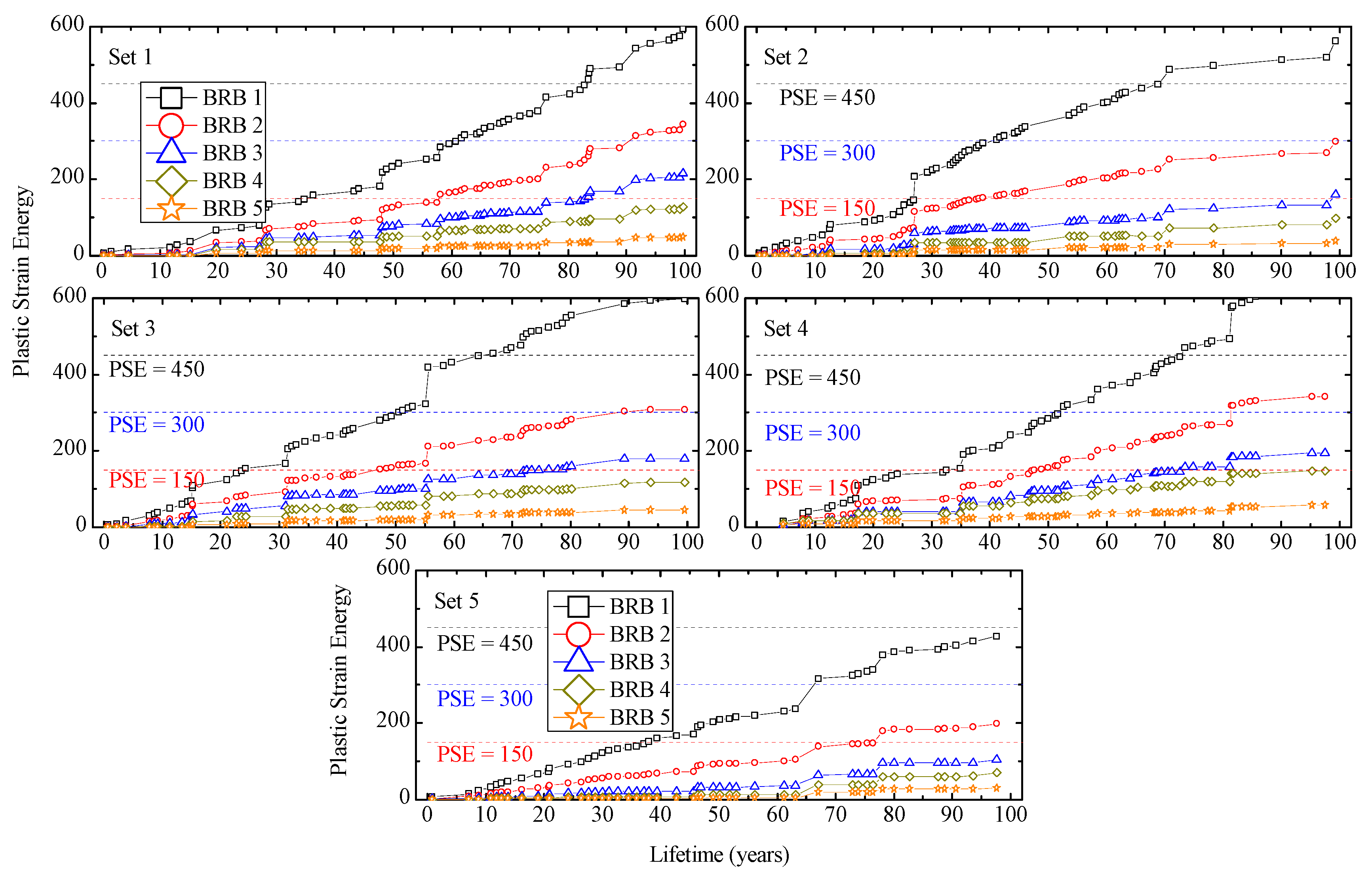

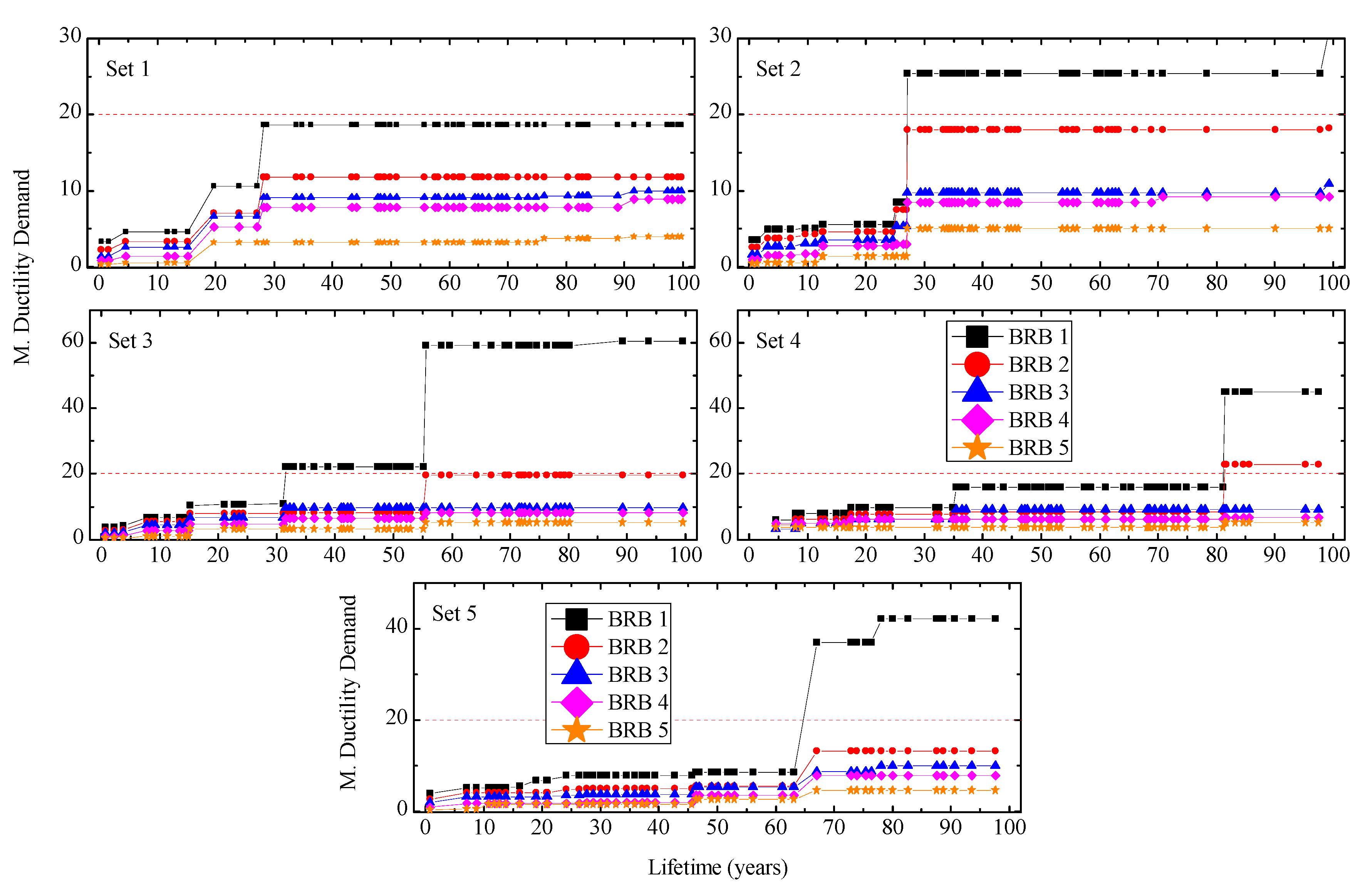
| Steel Beam | Steel Box Column | |||||
|---|---|---|---|---|---|---|
| Story | H × B | tW | tF | Story | H × B | t |
| 19–20 | 450 × 250 | 9 | 16 | - | - | - |
| 17–18 | 450 × 250 | 9 | 16 | 17–20 | 350 × 350 | 19 |
| 14–16 | 500 × 250 | 12 | 22 | 13–16 | 400 × 400 | 19 |
| 11–13 | 500 × 300 | 12 | 16 | 9–12 | 450 × 450 | 19 |
| 8–10 | 500 × 300 | 12 | 25 | 6–8 | 450 × 450 | 22 |
| 5–7 | 550 × 300 | 12 | 16 | 4–5 | 500 × 500 | 22 |
| 2–4 | 550 × 300 | 12 | 25 | 2–3 | 500 × 500 | 25 |
| 1 | 600 × 300 | 12 | 19 | 1 | 550 × 550 | 35 |
| Story | Yielding Capacity | Initial Stiffness | K1/Kai1 1 |
|---|---|---|---|
| Fiy (kN) | Kai (kN/mm) | ||
| 20 | - | - | - |
| 17–19 | 250 | 100 | 0.02 |
| 14–16 | 345 | 140 | 0.02 |
| 11–13 | 435 | 175 | 0.02 |
| 8–10 | 430 | 172 | 0.02 |
| 5–7 | 460 | 185 | 0.02 |
| 2–4 | 385 | 155 | 0.02 |
| 1 | - | - | - |
| Categories | No. | Event | Year | Station |
|---|---|---|---|---|
| Scaled earthquake to be compatible of 50 cm/s | 1 | Imperial Valley | 1940 | El Centro |
| 2 | Kern County | 1952 | Taft | |
| 3 | Kobe | 1995 | JMA | |
| Artificially generated earthquake to be compatible with Level 2 | 4 | Tohoku | 1978 | Tohoku Univ. |
| 5 | Tokachi Oki | 1968 | Hachinohe |
| Event | Intensity I 1,2 | Unit | Return Period (Years) | Recurrence Rate | Parameters | |
|---|---|---|---|---|---|---|
| a | b | |||||
| Earthquake | 600 | gal | 100 | 0.01 | −1.7898 | 0.0047 |
| 943 | gal | 500 | 0.002 | |||
| Wind | 16 | m/s | 1 | 1 | 4.9717 | 0.3107 |
| 36 | m/s | 500 | 0.002 | |||
| No. | Phase Spectrum | Component | Date | Station | Recorded PGA (gal) |
|---|---|---|---|---|---|
| 1 | Random Phase | - | - | - | >250.000 |
| 2 | Kumamoto | NS | 3 January 2019 | Wadamachi Eda | 261.697 |
| 3 | Tottori | NS | 6 October 2000 | Yonago City | 280.233 |
| 4 | Tottori | EW | 21 October 2016 | Kurayoshi City | 285.811 |
| 5 | Toho-Oki | NS | 4 October 1994 | Honamachi | 454.975 |
| 6 | Noto Hanto | NS | 25 March 2007 | Wajima City | 463.544 |
| 7 | Miyagi | EW | 26 May 2003 | Izumimachi | 655.161 |
| 8 | Iburi | NS | 6 September 2018 | Atsuma Kananuma | 662.241 |
| 9 | Osaka | NS | 18 June 2018 | Hirakata City | 690.169 |
| 10 | Tokachi-Oki | NS | 26 September 2003 | Makuhetsu-cho | 754.200 |
| 11 | Niigata-Chuetsu | NS | 23 October 2004 | Ojiya City Castle | 779.244 |
| 12 | Kushiro Oki | NS | 15 January 1993 | Kushiro | 814.906 |
| 13 | Kobe | NS | 17 January 1995 | JMA | 818.066 |
| 14 | Tohoku | EW | 11 March 2011 | Ofunato | 944.072 |
| No. | Description | Parameter | Unit |
|---|---|---|---|
| 1 | Turbulence Length Scale | 75.27 | m |
| 2 | Standard Deviation of Fluctuating Component | 6.73 | m/s |
| 3 | Cutoff Frequency | 5.00 | Hz |
| 4 | Mean of Duration | 7500.00 | s |
| 5 | Coefficient of Variation | 10.00 | % |
| Selected Damper | MH Scenarios | CDI | Strain Amplitude (%) | Cycle | Energy | |
|---|---|---|---|---|---|---|
| Ave. | Max | No. | kN-m | |||
| BRB#1 | Set 1 | 0.643 | 0.048 | 1.210 | 129,094 | 25,400 |
| Set 2 | 0.573 | 0.046 | 1.440 | 141,647 | 22,310 | |
| Set 3 | 0.501 | 0.042 | 1.018 | 138,566 | 21,310 | |
| Set 4 | 0.434 | 0.040 | 1.362 | 138,988 | 16,240 | |
| Set 5 | 0.363 | 0.043 | 1.092 | 126,927 | 13,120 | |
| BRB#2 | Set 1 | 0.105 | 0.031 | 0.800 | 128,968 | 3838 |
| Set 2 | 0.074 | 0.029 | 0.783 | 140,602 | 3074 | |
| Set 3 | 0.087 | 0.028 | 1.067 | 136,815 | 3564 | |
| Set 4 | 0.060 | 0.026 | 1.214 | 138,187 | 2038 | |
| Set 5 | 0.043 | 0.027 | 0.844 | 126,173 | 1356 | |
| BRB#3 | Set 1 | 0.032 | 0.025 | 0.762 | 129,226 | 930 |
| Set 2 | 0.026 | 0.024 | 0.758 | 139,249 | 751 | |
| Set 3 | 0.027 | 0.023 | 0.754 | 135,340 | 932 | |
| Set 4 | 0.024 | 0.021 | 0.701 | 137,201 | 654 | |
| Set 5 | 0.019 | 0.022 | 0.780 | 126,453 | 461 | |
| BRB#4 | Set 1 | 0.015 | 0.019 | 0.654 | 129,787 | 385 |
| Set 2 | 0.014 | 0.018 | 0.708 | 140,681 | 307 | |
| Set 3 | 0.015 | 0.018 | 0.664 | 134,786 | 365 | |
| Set 4 | 0.011 | 0.016 | 0.582 | 137,618 | 321 | |
| Set 5 | 0.011 | 0.016 | 0.698 | 126,165 | 234 | |
| BRB#5 | Set 1 | 0.005 | 0.009 | 1.210 | 142,085 | 99 |
| Set 2 | 0.004 | 0.008 | 0.339 | 152,142 | 94 | |
| Set 3 | 0.005 | 0.008 | 0.406 | 148,793 | 88 | |
| Set 4 | 0.004 | 0.008 | 0.367 | 151,671 | 83 | |
| Set 5 | 0.004 | 0.007 | 0.422 | 135,930 | 69 | |
Publisher’s Note: MDPI stays neutral with regard to jurisdictional claims in published maps and institutional affiliations. |
© 2021 by the authors. Licensee MDPI, Basel, Switzerland. This article is an open access article distributed under the terms and conditions of the Creative Commons Attribution (CC BY) license (https://creativecommons.org/licenses/by/4.0/).
Share and Cite
Naqi, A.; Roy, T.; Saito, T. Time-Dependent Damage Estimation of a High-Rise Steel Building Equipped with Buckling-Restrained Brace under a Series of Earthquakes and Winds. Appl. Sci. 2021, 11, 9253. https://doi.org/10.3390/app11199253
Naqi A, Roy T, Saito T. Time-Dependent Damage Estimation of a High-Rise Steel Building Equipped with Buckling-Restrained Brace under a Series of Earthquakes and Winds. Applied Sciences. 2021; 11(19):9253. https://doi.org/10.3390/app11199253
Chicago/Turabian StyleNaqi, Ahmad, Tathagata Roy, and Taiki Saito. 2021. "Time-Dependent Damage Estimation of a High-Rise Steel Building Equipped with Buckling-Restrained Brace under a Series of Earthquakes and Winds" Applied Sciences 11, no. 19: 9253. https://doi.org/10.3390/app11199253
APA StyleNaqi, A., Roy, T., & Saito, T. (2021). Time-Dependent Damage Estimation of a High-Rise Steel Building Equipped with Buckling-Restrained Brace under a Series of Earthquakes and Winds. Applied Sciences, 11(19), 9253. https://doi.org/10.3390/app11199253







